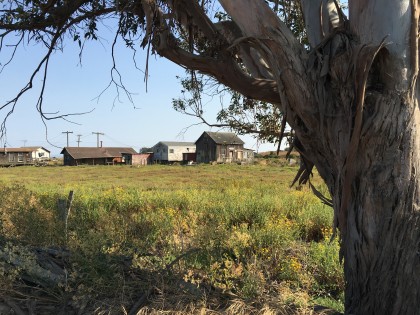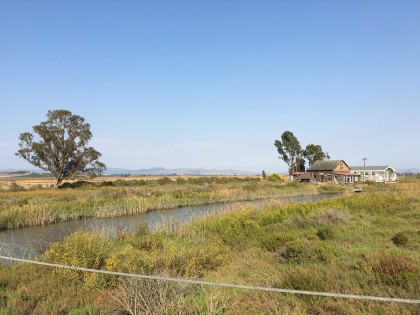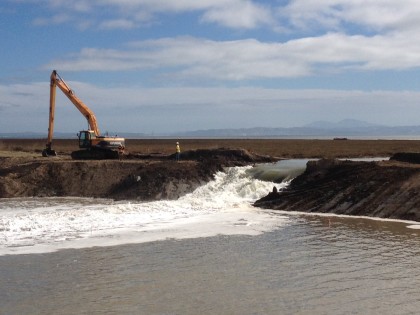A Look Down-Valley

Once a busy hub of commerce, Sonoma Valley’s long-dormant southern gateway is drawing renewed attention.
What we think of now as down-valley – made up of spots such as Schelleville, Wingo, Sears Point, Skagg’s Island, Tubb’s Island, Petaluma River, and Napa Sonoma Marsh – was once part of a remarkable wildlife ecosystem inhabited by local Native Americans, grizzly bears, elk, and all manner of birds, fish and mammals.
When the Spanish arrived, their diseases accompanied them into the countryside and depopulated vast areas. The Spanish ultimately encountered a great landscape mostly empty of people, a place that appeared magically manicured (by Native American intentional use of fire) and ready to inhabit.
During the Sonoma Valley Rancho Period in the 1830s (the coming of the white men), shipping was a crucial down-valley activity for the acquisition, selling and trading of resources. Ships proceeded from the uppermost point of navigation on Sonoma Creek, known as the Embarcadero, adjacent to the current Larson Winery on Millerick Rd., just south of the main Schell-Vista fire station.

In 1863 the Stofen brothers bought 190 acres near the Embarcadero and shipped freight, fruit and firewood by sloop. In 1874 the Stofens combined with another Embarcadero shipping interest and built a steamship line for freight and passenger service.
The Donohue railroad came in 1878 and by 1879 the Embarcadero steamer was out of business. The rail line ran up Eighth Street East and then west past Depot Park and through up the valley. Rail carried valley agricultural produce, quarry stone and resort-bound passengers – the proto-tourists.
Shipping by boat to the Embarcadero ultimately ended due to the silting-in of Sonoma Creek, a by-product of farming practices and increased sediments washed down into the Bay from hydraulic mining in the Gold Country.
Concomitant with the transition from sail to steam, during the early American Period (1848 and on), an era of diking began in the area. The process reclaimed tide and baylands to make them available for hay and dairy production. Ultimately some 90 percent of Bay Area tidal marshes would be lost to the creation of diked baylands. Some of these down-valley lands include Skagg’s Island, (a former naval communications station), Napa Sonoma Marsh (former salt ponds) and Sear’s Point, part of the huge former ranch of wagon train baron and real estate magnate Franklin Sears.
In the mid 1860s the Napa Sonoma Marsh was a top west coast wetland with habitat for millions of birds, and it remains, in spite of 13,000 acres of abandoned salt evaporation ponds, a prime area for present bay restoration projects.

Today the Sonoma Land Trust is turning private land to public good by restoring diked land to tidal march and wetlands near Sears Point. Given the eventuality of rising sea levels and higher storm surges, the newly restored baylands will protect and stabilize a new sea level equilibrium with natural mitigation systems, versus hard dikes that can be breached and flood all at once. The Trust has had to pay attention to protecting existing transportation infrastructure as well; North Bay connective route, Highway 37 may have to be raised and turned into a toll road.
South of Hwy 12/121 and extending over to the Petaluma River, are lands that comprise the North Bay Water District, an ag-oriented entity that is part of the creation of the emerging valley Groundwater Sustainability Agency. The GSA will manage and steer the Sonoma groundwater basin water towards future sustainability. Many of these lands are now in agricultural use as grazing for dairy cattle, hay production and some vineyards.
Flooding of Lower Sonoma Creek has been a bone of contention among locals for many years, at least since 2006 when a creek levee broke and flooded about 100 acres seven miles south of Schelleville. Management of the creek also plays into salmon restoration, and has been the cause of land use disputes between agricultural and environmental interests. In fact, the Bay is currently suffering a dearth of biodiversity caused by human-caused diversion of fresh water flows, and from the loss of tidal wetlands due to diking.
Unfortunately, no easy relief is at hand. A 2012 study prepared for the Sonoma County Water Agency found “no distinct preferred flood reduction alternative, largely due to the physical constraints inherent to the study area.” These constraints include the flat topography in the lower watershed, considerable tidal influence extending above Highway 121 and low ground elevations aggravated by land subsidence. Measures to stop the area from flooding, the study concluded, “are not physically feasible or… economically feasible.”
Other recent down-valley land use issues have been the “cows not casinos” fight of 1993. (The cows won.) More recently, the idea to allow large-scale concerts at Sonoma Raceway was proposed by the track, but then withdrawn.
Current down-valley land use activity includes a ramping up of events at Cornerstone, particularly with the arrival of Sunset Magazine as a tenant. The Wing and Barrel Ranch hunting club near Sears Point is expanding into a high-end facility, with 17,300 sq. ft. clubhouse and restaurant, plus dog boarding and other amenities. A giant transport warehouse on Hwy 121/12 and Eighth Street East is in the works, as is overall development of that corridor.
The Tolay Springs development near the raceway, owned by Chinese billionaire Zhu Wenchen, proposes multiple retail and production activities: wine tasting and sales; beer, distilled spirits and oils tasting and sales; produce market and cheese store; butcher shop; and a tea merchant. An addition to general foot (and car) traffic, the facility proposes to host 52 events a year.
And so, while the central Sonoma Valley seems bustling by comparison, down-valley life carries on, seemingly as sleepy and slow as its idyllic past. For now.
–Sun staff report
One thought on “A Look Down-Valley”
Comments are closed.




I fantasize about a second SMART train line across these sloughs from Novato to Schellville, Napa Junction, Suisun City, and beyond.